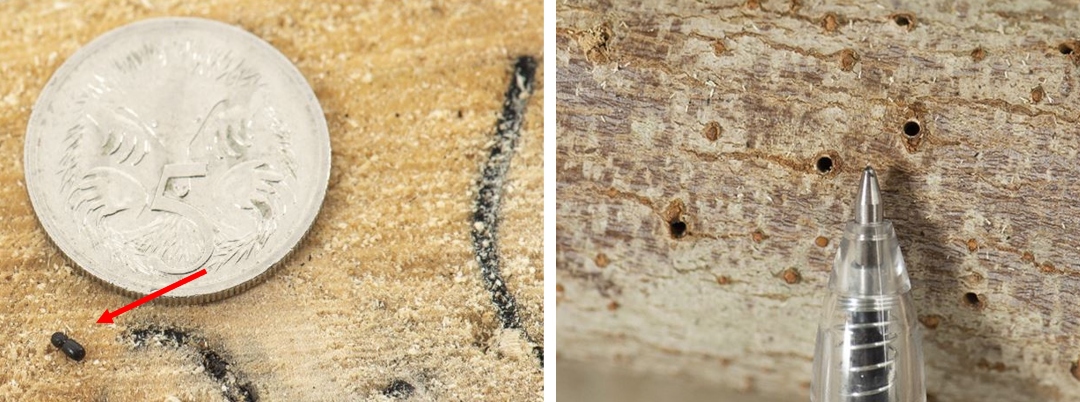Pictured above, left to right: Polyphagous shot-hole borer in a maple tree; Exit holes in a tree created by polyphagous shot-hole borer. This beetle attacks a wide range of plants by tunnelling into trunks, stems and branches. Establishment of this pest in WA would have significant impact on amenity trees, native vegetation, and the fruit and nut tree industries. Photos by P Scanlon DPIRD, WA
Please REPORT ANY SUSPECTED INFESTATIONS to DPIRD. Find out more at: DPIRD Polyphagous shot-hole borer
The Polyphagous Shot-hole Borer (PSHB) is a tiny beetle, native to East Asia, that bores into living trees which can result in tree death. It is considered both an agricultural and environmental pest with more than 400 host species including horticulture production, native and amenity trees.
The first detection of this pest in Australia was made in East Fremantle, WA in August 2021 when a member of the public reported symptoms of dieback and dead branches in their maple tree. It is possible PSHB hitchhiked to Australia on untreated wooden articles and packaging materials. Subsequent spread can be aided by the movement of infested wood (eg pruned trees, firewood) or wooden products such as furniture.
Current Situation, excerpted from DPIRD website 10 June 2022
The Department of Primary Industries and Regional Development is responding to the confirmed detections of the exotic beetle, Polyphagous Shot-Hole Borer (PSHB) in the Perth metropolitan area. Response activities include:
• Conducting surveillance to determine the distribution of PSHB
• Containing the pest to prevent further spread to non-infested regions within Western Australia
• Providing advice and information to residents, industry and other stakeholders
• Ensuring that all response activities are conducted safely, consistently and efficiently
To stop the spread, a Quarantine Area Notice (QAN) is in place to support the Department of Primary Industries and Regional Development’s ongoing surveillance program to determine the spread of the pest. A new Quarantine Area Notice came into effect on 13 May 2022 and now covers 21 local government areas.
What to look for:
The borer attacks a wide range of trees. The five important trees to check are maple, willow, plane, coral tree and avocado. The adult beetles and their larvae can be hard to spot as they spend most of their lives inside a tree, however, there are several signs that indicate the borer could be present including:
• multiple entrance holes on the trunk or branches that are up to 2 millimetres or the size of the tip on a ballpoint pen
• frass (powdery substance) extruding from the tree and crystalline foam which look like sugar volcanoes exuding from the entry holes
• thick resin or sap on the tree’s branches or trunk – this can sometimes push the beetle out of the gallery
• dark brown to black staining of the wood around entrance holes
• wilting and dying branches and eventually tree death
Symptoms usually start in the upper canopy. Spring and autumn are when the beetle is most visible.
Click on the following link for more information: https://www.agric.wa.gov.au/borer


Recent Comments